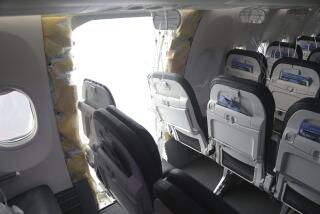Shuttle Advisory Panel Vows Independence from NASA
- Share via
KENNEDY SPACE CENTER, Fla. — The panel of experts set up to monitor NASA’s compliance with soon-to-be-released shuttle safety recommendations met publicly for the first time Thursday, with a veteran astronaut promising an independent assessment of the agency’s performance.
“Our task is to look at those things that have been recommended
The Columbia Accident Investigation Board -- which is probing the causes of the Feb. 1 shuttle breakup that killed seven astronauts -- is expected to release its findings Aug. 26; the recommendations likely will include a list of technical modifications to the three remaining orbiters, as well as to NASA management practices and operations.
“We will use our own processes, we will use our own determined sources of information to do our assessment,” said Covey, a decorated combat pilot who flew on four shuttle missions, including the first to follow the 1986 Challenger accident.
Tom Stafford, a veteran of four Gemini and Apollo space missions, is the other co-chairman of the panel. Other members include former high-ranking military officers; engineers and executives with NASA or private aerospace firms; academics; and a former director of the Congressional Budget Office.
NASA Administrator Sean O’Keefe has said the advisory panel is intended to serve as a “sanity check” to ensure that the National Aeronautics and Space Administration doesn’t move too quickly or omit steps in its eagerness to resume shuttle operations.
On Tuesday, William F. Readdy -- NASA’s associate administrator for space flight -- told reporters that the target for the next shuttle launch was March, although he acknowledged that date was probably “ambitious.”
The advisory board will serve only as a watchdog, Covey said, and will not have the authority to abort a shuttle launch if it believes the program is still unsafe.
“That’s not our role,” Covey said. “We can advise the [NASA] administrator that we’re unhappy with the direction that the return-to-flight activities are taking. Then it’s his job to call the halt.”
The independent Columbia Accident Investigation Board, chaired by retired Adm. Harold W. Gehman Jr., already has made five technical recommendations -- including equipping shuttles with more cameras that could take external pictures of the orbiters and their fuel tanks. It was Columbia’s external tank that shed insulating foam on liftoff from Kennedy Space Center on Jan. 16, likely puncturing the left wing and allowing dangerous, superheated gases to enter the craft on reentry.
In addition to mechanical problems, the board is expected to blame NASA’s management style for contributing to the Columbia tragedy. During the ill-fated 16-day mission, concerns voiced by lower-level engineers about the effects of the foam strike never reached top managers, or were downplayed.
Covey said that shuttle program managers already had sought the watchdog panel’s approval for steps they have undertaken to resume flight operations.
He and the other members of the group have been given a “narrow mandate,” Covey said, to verify how recommendations for getting the orbiters flying again are carried out. But he also said the panel had been empowered to make observations about safety and operational readiness as it deemed necessary.
“If we see things that concern us or we have issues with, we will identify those as part of our assessment,” he said.
Over three days at Kennedy Space Center, panel members viewed the charred, twisted debris recovered from Columbia and familiarized themselves with shuttle operations and personnel. They held a public meeting Thursday at the space center’s visitors complex, and planned to meet again in the second week of September at the Johnson Space Center in Houston.
According to one expert, the advisory group’s creation, to ride herd on NASA management, represents a valuable lesson learned.
“The Columbia investigation board has expressed considerable concerns that the recommendations which followed the Challenger disaster were never fully implemented,” said Charles Eastlake, professor of aeronautical engineering at Embry-Riddle Aeronautical University in Daytona Beach, Fla.
“This task group clarifies the picture of who’s responsible. It will make it easier to do what’s necessary to take a decision. There will be no question of who you talk to if you have a question.”
Covey said the panel’s intent was to issue its final report a month before the next scheduled shuttle flight and then disband.
More to Read
Sign up for Essential California
The most important California stories and recommendations in your inbox every morning.
You may occasionally receive promotional content from the Los Angeles Times.










